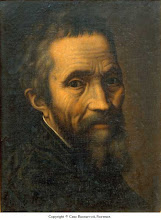The following is a part of a letter Michelangelo wrote to his nephew concerning the work he wanted to do for God.
"Many believe, -- and I believe -- that I have been designated for this work by God. In spite of my old age, I do not want to give it up; I work out of love for God and I put all my hope in Him."
The following is a letter Michelangelo wrote about being harassing to get the work done.
"I spend my days supervising the construction of St. Peter's. The Vatican's financial superintendent keeps harassing me for a progress report. My response: your lordship, I am not obliged to, nor do I intend to, tell you anything. Your job is to keep the money rolling in, and out of the hands of thieves. I will see to the building."
This is part of a letter Michelangelo wrote to Giorgio Vasari about finishing the building."So, Vasari, God wants me to encumber him for a few more years. I know you will tell me I am a crazy old man to write sonnets -- but since many people say that I have become gaga, I have to live up to my reputation. I can feel through your letter the affection you feel for me. Yes, I would like to move my old bones next to those of my father, as you beseech me to do. But if I left Rome, I would feel guilty of dooming Saint Peter's to failure, and that would be a great shame and a deadly sin. When enough of the construction is done and nothing can be changed to it any more, I hope to follow your advice -- when it is no longer important to frustrate the appetites of those who hope that I will leave soon."






 One of the most famous stories of the Bible is the
One of the most famous stories of the Bible is the 
 It seems at this point my blog is not allowing me to post pictures. Hopefully I can do that soon.
It seems at this point my blog is not allowing me to post pictures. Hopefully I can do that soon.









